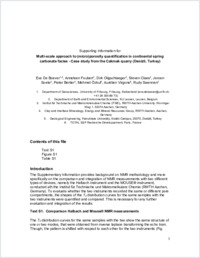Multiscale approach to (micro)porosity quantification in continental spring carbonate facies: Case study from the Cakmak quarry (Denizli, Turkey)
- Boever, Eva De Department of Geosciences, University of Fribourg, Switzerland - Department of Earth and Environmental Sciences, KU Leuven, Belgium
- Foubert, Anneleen Department of Geosciences, University of Fribourg, Switzerland
- Oligschlaeger, Dirk Institut für Technische und Makromolekulare Chemie, RWTH Aachen University, Aachen, Germany
- Claes, Steven Department of Earth and Environmental Sciences, KU Leuven, Belgium
- Soete, Jeroen Department of Earth and Environmental Sciences, KU Leuven, Belgium
- Bertier, Pieter Clay and Interface Mineralogy, Energy and Mineral Resources Group, RWTH Aachen, Germany
- Özkul, Mehmet Geological Engineering, Pamukkale University, Denizli, Turkey
- Virgone, Aurélien TOTAL E&P Recherche Développement, Paris, France -
- Swennen, Rudy Department of Earth and Environmental Sciences, KU Leuven, Belgium
-
01.07.2016
Published in:
- Geochemistry, Geophysics, Geosystems. - 2016, vol. 17, no. 7, p. 2922–2939
English
Carbonate spring deposits gained renewed interest as potential contributors to subsurface reservoirs and as continental archives of environmental changes. In contrast to their fabrics, petrophysical characteristics – and especially the importance of microporosity (< 1µm) – are less understood. This study presents the combination of advanced petrophysical and imaging techniques to investigate the pore network characteristics of three, common and widespread spring carbonate facies, as exposed in the Pleistocene Cakmak quarry (Denizli, Turkey): the extended Pond, the dipping crystalline Proximal Slope Facies and the draping Apron and Channel Facies deposits formed by encrustation of biological substrate. Integrating mercury injection capillary pressure, bulk and diffusion Nuclear Magnetic Resonance (NMR), NMR profiling and Brunauer–Emmett–Teller (BET) measurements with microscopy and micro-computer tomography (µ-CT), shows that NMR T2 distributions systematically display a single group of micro-sized pore bodies, making up between 6 and 33% of the pore space (average NMR T2 cut-off value: 62 ms). Micropore bodies are systematically located within cloudy crystal cores of granular and dendritic crystal textures in all facies. The investigated properties therefore do not reveal differences in micropore size or shape with respect to more or less biology-associated facies. The pore network of the travertine facies is distinctive in terms of (i) the percentage of microporosity, (ii) the connectivity of micropores with meso- to macropores, and (ii) the degree of heterogeneity at micro- and macroscale. Results show that an approach involving different NMR experiments provided the most complete view on the 3-D pore network especially when microporosity and connectivity are of interest.
- Faculty
- Faculté des sciences et de médecine
- Department
- Département de Géosciences
- Language
-
- English
- Classification
- Geology
- License
-
License undefined
- Identifiers
-
- RERO DOC 277685
- DOI 10.1002/2016GC006382
- Persistent URL
- https://folia.unifr.ch/unifr/documents/305098
Other files
Statistics
Document views: 132
File downloads:
- Supplementary material: 139
- pdf: 210

